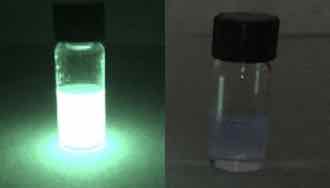By American Chemical Society —— Bio and Archives--March 9, 2017
 Any child who has played with a glowstick or captured a firefly understands the wonder of chemiluminescence, or chemical light. This process is already used to detect blood at crime scenes and to determine the concentrations of different components of biological samples. This week in ACS Central Science, researchers introduce a new chemiluminescent probe that is better for use in water and up to 3,000 times brighter than previous probes.
Chemiluminescent probes are among the most sensitive diagnostic tools for DNA sequencing, crime scene analysis and immunoassays. Most systems use a cocktail with one emitter molecule that detects the species of interest by giving off weak light, and another two additional ingredients — a fluorophore and a soap-like substance called a surfactant — that amplify the signal to detectable levels. However, energy is lost in the transfer process from one molecule to the other, and surfactants are not biocompatible. Doron Shabat and colleagues proposed that by tweaking the electronic structure of current probes to improve their inherent fluorescence, they could create a new single-component emission system that would work for many applications.
Any child who has played with a glowstick or captured a firefly understands the wonder of chemiluminescence, or chemical light. This process is already used to detect blood at crime scenes and to determine the concentrations of different components of biological samples. This week in ACS Central Science, researchers introduce a new chemiluminescent probe that is better for use in water and up to 3,000 times brighter than previous probes.
Chemiluminescent probes are among the most sensitive diagnostic tools for DNA sequencing, crime scene analysis and immunoassays. Most systems use a cocktail with one emitter molecule that detects the species of interest by giving off weak light, and another two additional ingredients — a fluorophore and a soap-like substance called a surfactant — that amplify the signal to detectable levels. However, energy is lost in the transfer process from one molecule to the other, and surfactants are not biocompatible. Doron Shabat and colleagues proposed that by tweaking the electronic structure of current probes to improve their inherent fluorescence, they could create a new single-component emission system that would work for many applications.
The Comment section of online publications is the new front in the ongoing Cancel Culture Battle.
Big Tech and Big Media are gunning for the Conservative Voice—through their Comment Sections.
Canada Free Press wishes to stay in the fight, and we want our fans, followers, commenters there with us.
We ask only that commenters keep it civil, keep it clean.
Thank You for your patience and for staying aboard the CFP ‘Mother Ship’.
READ OUR Commenting Policy